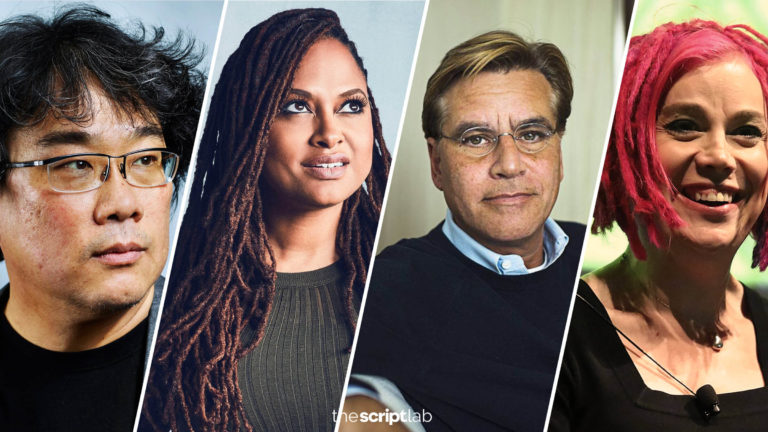Sign up for the
TSL Newsletter
and get $50 off Final Draft 12
By David Young · October 6, 2021

Writing is a process. Of that, we can be entirely sure. However, it’s not the same for everyone. Even the most iconic and successful writers we know of have their own process, their own rituals, their own goals when writing — and so should you!
In the hopes of finding your own, read on to see the writing rituals of several iconic screenwriters.
A “rather slow writer” by his own admission, Bong Joon-Ho has to leave home to get his work done. Like a lot of us, he says if he stays home, he’ll get lazy, just fall asleep, or watch television. Can you blame him? To combat this, Joon-Ho is known to do the most iconic ritual known to writers everywhere: he goes to a coffee shop, which he says forces him to actually get to his writing.
Ryan Murphy, especially when working on TV shows, confesses that he doesn’t have a regular writing schedule. Instead, his process involves mulling over the idea of an episode for days on end before spewing his next piece all at once. He also says he focuses on the language of a script: whether it’s to concoct a descriptive simile or “use the most specific, active verb or visual you can”, he finds this language control is an important tool in his success.
Fleshing out characters is a crucial part of what Ava DuVernay sees in the heart of every story. She spends time fleshing out even supporting characters, and she often will take to writing mini-scripts in the perspective of whatever character she’s focusing on. She finds it helps in connecting the characters with her audience later on.
Taika Waititi hates typing. “Really horrible,” he called it. He outlines by hand first, long before any typing occurs, so he doesn’t have to sit in front of the keyboard, wondering, “What’s next?” Better yet, his outline starts with the first and last scene: where he starts, and where he wants to go — a clever way to make sure his plot stays true when he fills in the blanks!

Taika Waititi
Aaron Sorkin looks for inspiration from existing conversations, from observations of people, taking his cues from even a room with only two people and a disagreement. He calls that “a scene to be written”. But Sorkin also gets active when he writes, finding himself often acting out parts, talking, blocking, even pacing through his neighborhood while poring over a script.
Hearkening back to the Stepford Wives and Rosemary’s Baby, he rewatched these to understand Ira Levin’s approach more intimately, and to emulate that in his own original work in Get Out. It’s important to know what you like in a movie, and Peele certainly does, so he found inspiration in watching other classic works.
Not only does he like to seat himself in the kitchen with a view of the Hollywood Hills, but Gus Van Sant also makes sure he at least dedicates about three hours a day at the beginning of the day. After this three-hour period, Van Sant allows himself to work at a different pace later if needed.
Worldbuilding and inspiration can come at a different pace for everyone, and for Dee Rees, it often comes at a trickle, with her and her collaborators often reaching out in the wee hours of the night with an inspiring passage, a poem, a song, or any other offering from what she calls her “knights of the roundtable.”

Dee Rees
In the end, screenwriting is a visual medium. Wes Anderson, with this in mind, pictures the visuals he wants in a movie first. That helps him set up scenes mentally, with the story being a secondary vehicle that fits the created world.
Steve McQueen just starts with a sentence. He starts there and lets the flow take him all the way to the film itself, even avoiding storyboards as he films “by the cuff” with his fluid script in hand. Talk about living in the moment!
It’s all about free association, according to Steven de Souza. Writing whatever he can on some good old 3-by-5 index cards, he’ll note odd observations in his day-to-day, or think of a piece of dialogue, already well prepared for impromptu note-taking.
Sometimes time alone is all you need. Sofia Coppola needs time to think and be passive — meaning she needs to set up dedicated times for a babysitter to give her that option, giving her the prescribed three hours a day she needs.

Sofia Coppola
Sisters Lana and Lilly Wachowski like to take chances. That’s how they found themselves writing a screenplay for the novel Cloud Atlas before even reaching out to the author, and they fell in love with the story so much that their gamble turned into a bid for the author’s permission. Write first, get permission later!
Like many of us, Tze Chun learned the hard way that rewriting takes forever. Luckily for him, he also found that structuring (and restructuring) his screenplay with a working outline first saved him a ton of time. Ain’t that the truth?
Robin Swicord does a lot of thinking out loud, and on paper, before the actual script begins. She explains, “I imagine ways to make it as visual as possible, how scenes will push other scenes,” and she even spends a vast amount of time figuring out the theme of the story she’s imagined.
Like a “big ball of dough” in his own words, Francis Ford Coppola likes to amass writing in big dumps, getting to about 60 or 70 pages before he starts turning it into a narrative. Before then, it’s just a bunch of thoughts — and after, it’s something with a story.
Shane Black goes through his day like an open conversation. If a thought hits him, he writes a scene or mini-story that makes sense of that thought, or that has an impact on him at the time. Later, when he’s ready to put something into a fully formed narrative, he picks from these little anecdotes from the “shoebox” of his mind.

Shane Black
There are many ways to get a job done. Writing is no different when it gets down to the process and the rituals writers take part in. We all have to get our work done somehow, and you might just find that some of the rituals and processes above make sense for your writing, for your mind. If so, give them a go! You might have just stumbled onto a personal tradition of your very own.
—
 David Wayne Young is an independent film producer and screenwriter with years of experience in story analysis, even providing coverage for multiple international screenwriting competitions. David’s obsessions include weird fiction and cosmic horror, and he’s formally trained in the art of tasting and preparing gourmet coffee in various worldly traditions, from Turkish coffee to hand-tamped espresso — all enjoyed while writing, of course.
David Wayne Young is an independent film producer and screenwriter with years of experience in story analysis, even providing coverage for multiple international screenwriting competitions. David’s obsessions include weird fiction and cosmic horror, and he’s formally trained in the art of tasting and preparing gourmet coffee in various worldly traditions, from Turkish coffee to hand-tamped espresso — all enjoyed while writing, of course.